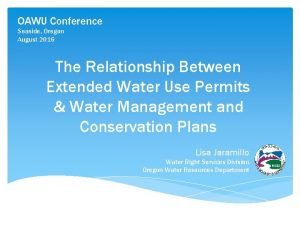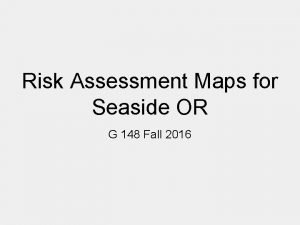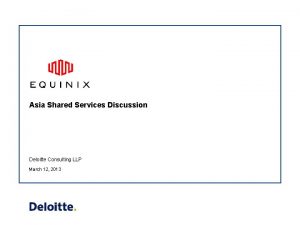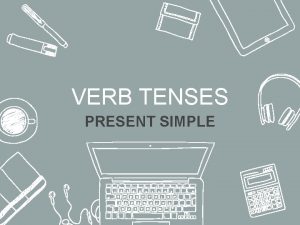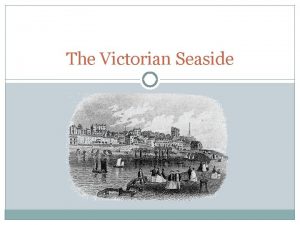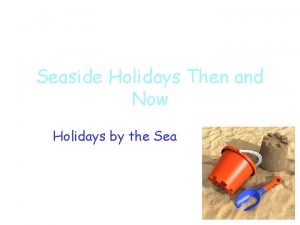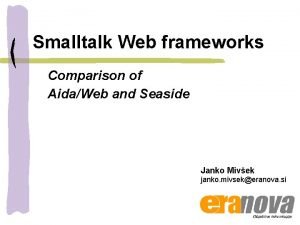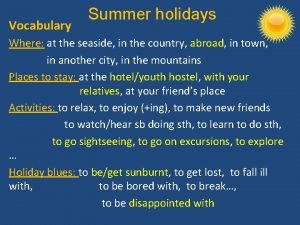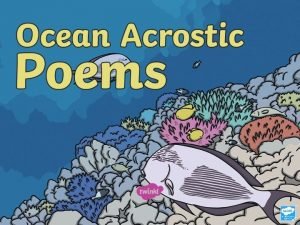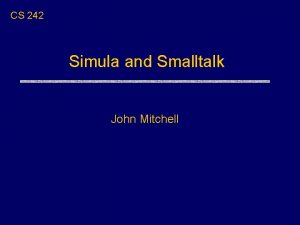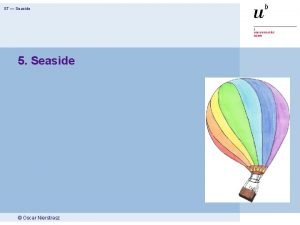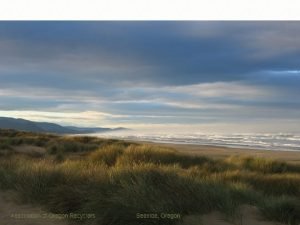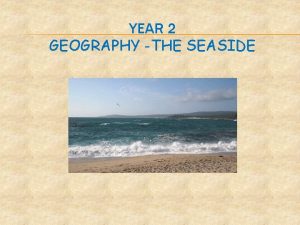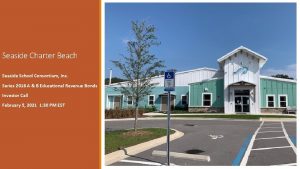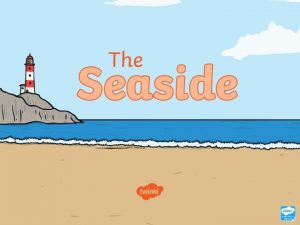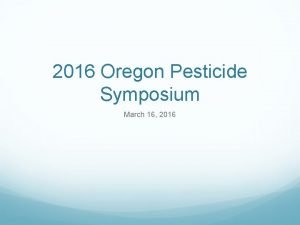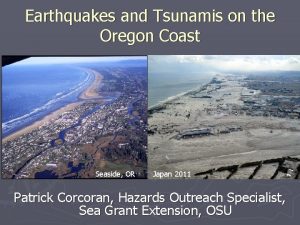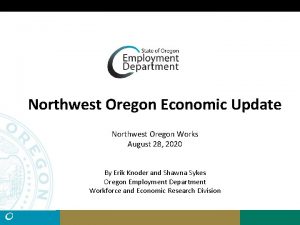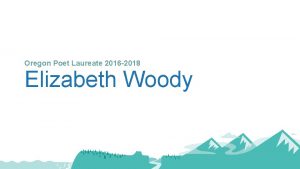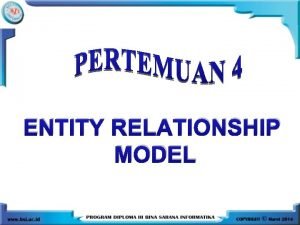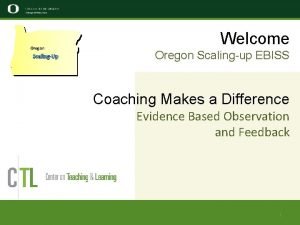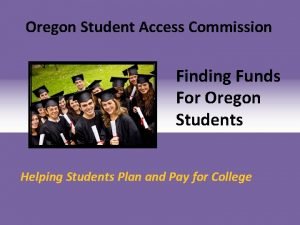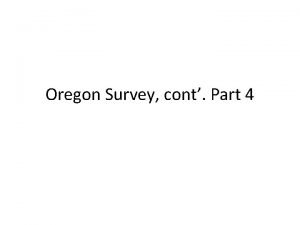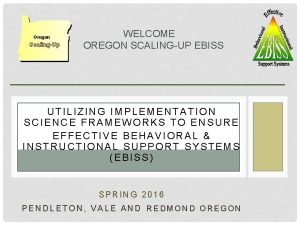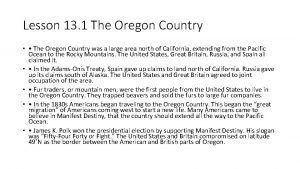OAWU Conference Seaside Oregon August 2016 The Relationship













































- Slides: 45

OAWU Conference Seaside, Oregon August 2016 The Relationship Between Extended Water Use Permits & Water Management and Conservation Plans Lisa Jaramillo Water Right Services Division Oregon Water Resources Department

Water Use Permits Upon its issuance, the water use permit will specify the deadline for: Completing construction; and Beneficially using all of the water allowed under the permit.

Permit Extensions of Time If a permit holder cannot complete construction and/or accomplish full beneficial use of water by the permit’s deadline… An Application for Extension of Time can be submitted.

Extended Water Use Permits - Municipal and Quasi-Municipal Uses - An approved Extension of Time for most Municipal Water Use Permits and some Quasi. Municipal Use Permits will: Require submittal of a WMCP within 3 years; and Limit the amount of water that may legally be diverted or appropriated under the permit. (i. e. , the “Development Limitations” Limitations Condition)

“Development Limitations” Condition A “Development Limitations” Limitations condition freezes the amount of water that a water supplier is legally authorized to divert under an extended permit. Based on maximum diversion rate (or duty, if applicable) for beneficial use accomplished before the permit’s most recently authorized completion date. (i. e. , before the most recent extension) Reflects the “developed portion” portion of the permit. Cannot exceed diversion rate limitation until authorized by OWRD through the WMCP process.

The “Developed Portion” The “developed portion” portion of an extended permit refers to the maximum rate (or duty) of water diverted for beneficial use before the extension. Final Order approving an Extension of Time for Municipal or Quasi-Municipal Permits will identify the developed portion of the permit in the “Development Limitations” condition.

Sample “Development Limitations” Condition Permit Extension of Time Final Order: City of Anytown – Permit S-112345 (4. 0 cfs) Development Limitations: Diversion of water beyond 1. 75 cfs (out of the total permitted 4. 0 cfs of water) under Permit S-112345 shall only be authorized upon issuance of a final order approving a Water Management and Conservation Plan under OAR Chapter 690, Division 86 that authorizes access to a greater rate of diversion of water under the permit consistent with OAR 690 -086 -130(7). The required Water Management and Conservation Plan shall be submitted to the Department within 3 years of this Final Order. Use of water under Permit S-112345 must be consistent with this and subsequent WMCPs approved under OAR Chapter 690, Division 86 on file with the Department…

The “Undeveloped Portion” In contrast, the “undeveloped portion” portion of an extended permit is… The portion of the permit that is the difference between the maximum rate specified in the permit and the maximum rate diverted for beneficial use before the extension Maximum Allowed Rate of Permit Develope d Portion Undevelop ed Portion

Water is Red Light Water? The term “Red Light Water” Water refers to the portion of the extended permit that the supplier is not yet legally authorized to divert… The remaining amount of water above the specified diversion rate limitation in the most recent Development Limitations condition in an Extension of Time Final Order. (i. e. , the “undeveloped portion”) The portion of the extended permit not currently authorized (i. e. , “Greenlighted”) for diversion in a

What is Greenlight Water? The term “Greenlight Water” Water refers to the quantity of water beyond the “developed portion” of an extended permit to which the supplier has obtained legal authorization from OWRD to divert. Accomplished through the WMCP process.

Sample Scenario – 4. 0 cfs Permit Prior to Extension of Time… The supplier diverted 1. 75 cfs for beneficial use. This is the “developed portion” portion of the extended permit. The remainder of the permit (2. 25 cfs) cfs is frozen and cannot be diverted. This is the “undeveloped portion” portion of

Sample Scenario - Requesting “Greenlight Water” The City submits a WMCP requesting and justifying the need for water in quantities above the “developed portion. ” Requesting 1. 25 cfs of water be “Greenlighted” Greenlighted under the permit. Once approved… the City is legally authorized to divert a total of 3. 0 cfs (Developed Portion + Greenlight Water = 3. 0 cfs) There is still 1. 0 cfs of “Red Light Water” under the permit.

WMCPs and Requests for “Greenlight Water” Authorization to divert quantities of water beyond the amount specified in a “Development Limitations” condition… May only be granted through OWRD’s review and approval of a WMCP that requests “Greenlight Water. ”

WMCPs and Requests for “Greenlight Water” To request “Greenlight Water, ” the WMCP must include: A quantification of the amount of water the supplier needs under each extended permit over the next 20 years to help meet its projected demands for water; and The required documentation to support and justify the need for the “Greenlight Water” and that it is the most feasible and appropriate water supply

Justifying a Request for “Greenlight Water” The justification for “Greenlight Water” in the WMCP needs to consider alternative water sources, including: Interconnection with other municipal water suppliers or regional water management; and Water savings from implementation of conservation measures. The WMCP also needs to describe any mitigation actions the water supplier is taking to comply with

Authorization of “Greenlight Water” If the WMCP provides clear justification that “Greenlight Water” is necessary and that the water supplier is managing and conserving its water in a responsible manner… OWRD will issue a Final Order that: Approves the WMCP; and Includes a new “Development Limitations” condition that specifically grants authorization to a greater rate of diversion under the extended permit.

Resources Municipal Water Management and Conservation Plan Guidebook (March 2015) www. oregon. gov/owrd/docs/wmcp_guidebook. pd f

Contact Water Supply and Conservation Team Transfer and Conservation Section Kerri Cope Phone: 503 -986 -0919 Email: Kerri. H. Cope@wrd. state. or. us Chris Kowitz Phone: 503 -986 -0883 Email: Chris. C. Kowitz@wrd. state. or. us

Contact Lisa Jaramillo, Manager Transfer and Conservation Section Water Right Services Division Oregon Water Resources Department Phone: 503 -986 -0880 Email: Lisa. J. Jaramillo@wrd. state. or. us

OAWU Conference Seaside, Oregon August 2016 Registrations of Reclaimed Municipal Water Use Kerri Cope Water Management and Conservation Analyst Oregon Water Resources Department

What is “Reclaimed Water? ” As defined in ORS 537. 131, 540. 510 and 540. 610, water that has been used for municipal purposes and after such use has been treated in a treatment works (NPDES or WPCF), and that as a result is suitable for direct beneficial use that could not otherwise occur.

The DEQ/OWRD Connection �Use of Reclaimed Water is authorized by a National Pollutant Discharge Elimination System (NPDES) or Water Pollution Control Facility (WPCF) permit from Oregon Department of Environmental Quality (DEQ) under their Division 55 Rules for “Recycled Water” use.

The DEQ/OWRD Connection �DEQ is the state’s lead agency on water reuse. �DEQ issues NPDES and WPCF permits. DEQ and OWRD use different terminology for water reuse: �DEQ uses the term “recycled” water; �OWRD uses the term “reclaimed” water.

What are the Benefits? �Beneficial use of this water with an OWRD “Registration” provides an exemption from OWRD’s permitting requirements. �Reduces the quantity of warm, nutrient-rich wastewater that is discharged into local waterbodies.

What are the Benefits? �No fee required for registration, so cheaper (free!) than the OWRD water right permit process. �Can be used in place of, or supplemental to, an existing water right. �Can provide revenue to municipalities and help meet their DEQ permit requirements.

Who Can Use This Water? �Agricultural – Irrigation (nutrient content!). �Golf Courses – Irrigation for Recreation. �Industry – Cooling Systems, Boiler Feed, Process Water. �Municipalities, etc. – Groundwater Recharge, Fire Protection, and Irrigation (ex. city park).

The Process ORS 537. 132 provides the criteria under which the use of reclaimed water is exempt from OWRD water use permitting requirements. Exempt reclaimed water use requires: �A DEQ-issued NPDES or WPCF permit and; �An OWRD Reclaimed Municipal Water Use Registration and a Map showing the Place of Use (POU).

A Registration of Reclaimed Municipal Water form is filed with DEQ

Cont… �DEQ signs the registration form, attesting to 537. 132(1)(a)(b)&(c) and DEQ forwards the form to OWRD in Salem for evaluation (537. 132 defined later in the presentation). �OWRD staff evaluates the registration according to ORS 537. 132 and coordinates with the local watermaster to determine feasibility, etc. (60 days).

What About Existing Water Rights? ORS 540. 610(2)(h) – reclaimed water used in lieu of using water under an existing water right provides a rebuttal to the presumption of forfeiture for non-use of the water right. �The Registration document itself is not proof of use. �The DEQ permit requires an annual report of reclaimed water use (which provides proof of documentation to demonstrate use).

Clarification Does a Registration need to be filed if the reclaimed water use will occur inside the service boundary of the municipality that produced and treated (at a WCPF) the wastewater ? �A Reclaimed Water Use Registration needs to be filed regardless of whether the reclaimed water use will occur inside or outside the service boundary.

Who’s Responsible? Under ORS 537. 132(2), any person using or intending to use reclaimed water shall file a Reclaimed Water Use Registration form. �The Registrant is not always the landowner where reuse will occur, nor the supplier of the reclaimed water. �If there are multiple users of a city’s reclaimed water, then each user will need to submit a Registration with a map.

Say what? So here’s the deal: �You and your neighbor are farmers. You both want to use “Central City’s” reclaimed water in addition to your current water rights. �You will each need to submit a Reclaimed Water Use Registration form with a map showing your intended place of use.

What about Downstream Water Users? The statute states: �If the wastewater discharge was more than 50% of the “total average flow” of the stream for 5 or more years, affected downstream water users have preference to use of the reclaimed water.

New Registration Process As previously stated, each person using or intending to use reclaimed water completes a separate Registration form and submits it to the DEQ permit writer along with the application for a DEQ permit (NPDES/ WPCF).

New Registration Process �Registration must be signed by the Registrant (the water user) and the Water Supplier. �Registrant must supply a map of water right application quality (Township, Range, Section, QQ) showing the Place of Use (POU).

New Registration Process DEQ signs the Registration form and affirms: (537. 132(1)(a)(b)&(c) ) �Once the application for a DEQ permit (NPDES/WPCF) is approved; the reuse will be authorized under that permit; �They have determined, in consultation with ODFW, that the reuse will not have a significant impact on fish and; �The intent of reuse is to improve stream water quality.

New Registration Process Then, DEQ sends the Registration form to the OWRD “Reuse Coordinator” in Salem (that’s me). Within 60 days of receipt of the Registration the Reuse Coordinator will: �Email a copy to the appropriate Watermaster and; �Enter the Registration into OWRD’s WRIS database.

New Registration Process �Confer with Watermaster on streamflow impacts and to existing downstream water right holders. �If the reuse is for aquifer recharge, confer with the appropriate OWRD Hydrogeologist.

Letter of Acceptance/Rejection �A letter either accepting or rejecting the use will be sent to the registrant, watermaster and DEQ. �Registration is tracked in OWRD’s Water Rights Information System (WRIS) database.

What about WRIS? �Registrations will be coded as “RM” files (example RM-210). �Data will include the maximum rate of the reuse and the place of use by T, R, S, Q-Q (so the water reuse and it’s location are searchable).

What about WRIS? �A scanned image of the Registration form and of the map will be available. �The Registration will be tied to existing water rights located on the same land (if applicable). �The Registration will be valid as long as DEQ authorizes the reclaimed water use.

RM 210

So Basically…. �The “Registrant” is the user of the reclaimed water. �The Registration goes to DEQ with the NPDES/WPCF application. �DEQ consults with ODFW, then signs off on the Registration and sends it to OWRD. �Actual use of reclaimed water in lieu of using underlying water rights provides protection from forfeiture for nonuse. �For water reuse to be exempt from water right permitting, both a DEQ Permit and Registration are required.

Questions? Kerri H. Cope Water Management and Conservation Specialist (Water Reuse Coordinator) Kerri. H. Cope@WRD. state. or. us 503 -986 -0919
 Oawu seaside conference
Oawu seaside conference Google maps seaside oregon
Google maps seaside oregon Deloitte shared service center inc
Deloitte shared service center inc Seaside now and then
Seaside now and then The browns goes to the seaside every summer
The browns goes to the seaside every summer Seaside marina di pisa
Seaside marina di pisa Seaside in the past
Seaside in the past The seaside in the past
The seaside in the past Victorian seaside
Victorian seaside Victorian seaside holidays
Victorian seaside holidays Seaside safety
Seaside safety Xxx
Xxx Seaside now and then
Seaside now and then Controler
Controler Seaside vocabulary
Seaside vocabulary Hunting acrostic poem
Hunting acrostic poem Smalltalk seaside
Smalltalk seaside Seaside holidays now and then
Seaside holidays now and then Importance of relationship marketing
Importance of relationship marketing Biện pháp chống mỏi cơ
Biện pháp chống mỏi cơ độ dài liên kết
độ dài liên kết Voi kéo gỗ như thế nào
Voi kéo gỗ như thế nào Thiếu nhi thế giới liên hoan
Thiếu nhi thế giới liên hoan Vẽ hình chiếu vuông góc của vật thể sau
Vẽ hình chiếu vuông góc của vật thể sau điện thế nghỉ
điện thế nghỉ Một số thể thơ truyền thống
Một số thể thơ truyền thống Trời xanh đây là của chúng ta thể thơ
Trời xanh đây là của chúng ta thể thơ Thế nào là hệ số cao nhất
Thế nào là hệ số cao nhất Hệ hô hấp
Hệ hô hấp Bảng số nguyên tố
Bảng số nguyên tố đặc điểm cơ thể của người tối cổ
đặc điểm cơ thể của người tối cổ Các châu lục và đại dương trên thế giới
Các châu lục và đại dương trên thế giới Tư thế worm breton
Tư thế worm breton ưu thế lai là gì
ưu thế lai là gì Tư thế ngồi viết
Tư thế ngồi viết Cái miệng nó xinh thế chỉ nói điều hay thôi
Cái miệng nó xinh thế chỉ nói điều hay thôi Các châu lục và đại dương trên thế giới
Các châu lục và đại dương trên thế giới Cách giải mật thư tọa độ
Cách giải mật thư tọa độ Bổ thể
Bổ thể Từ ngữ thể hiện lòng nhân hậu
Từ ngữ thể hiện lòng nhân hậu Tư thế ngồi viết
Tư thế ngồi viết Thẻ vin
Thẻ vin Thứ tự các dấu thăng giáng ở hóa biểu
Thứ tự các dấu thăng giáng ở hóa biểu Thể thơ truyền thống
Thể thơ truyền thống Hát lên người ơi alleluia
Hát lên người ơi alleluia
